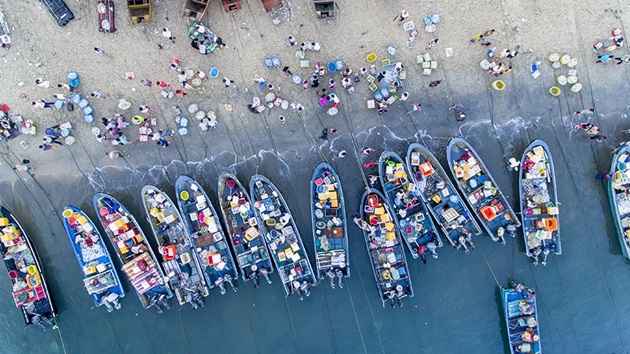New figures from the Marine Stewardship Council (MSC) show that ending overfishing could provide nutrition for millions of additional people, helping to prevent serious and life-threatening health conditions. Seafood is one of the most-nutrient rich foods,
packed with vitamins, and already provides a fifth of the daily protein needs of over 3 billion people globally. [1]
Latest estimates suggest if all global fisheries were managed sustainably, 16 million tonnes more seafood could be harvested every year. [2] This additional catch together with the 96 million tonnes of wild seafood catch currently projected for 2030 [3]
could prevent iron deficiencies in 4 million people and vitamin B12 deficiencies in 18 million people [4]. This could help alleviate anaemia, a global public health problem that affects nearly half of young children under five and 40% of pregnant
women globally.[5]
The increased total catch could also help eliminate zinc and calcium deficiencies in more than two and a half million and 24 million people respectively while increasing vitamin A intakes for five million people.[6] Deficiency in vitamin A alone is the
leading cause of preventable blindness in children.[7]
The MSC said that to realise the benefits of aquatic foods, governments must put them at the heart of their national food strategies, setting enabling rules to ensure that sustainable fisheries are recognised and supported, as well as improving access
to nutrition-rich seafood, especially in emerging economies.
The not-for-profit’s analysis found that 38 million people missing out on healthy levels of essential Omega-3 fatty acids (DHA and EPA)[8], which are mainly found in seafood [9], could also have their daily requirements met if the oceans are fished
sustainably, helping to reduce deaths from heart disease and strokes.[10]
The estimates are derived from the
Aquatic Foods Composition Database,[11], a product of the
Golden Lab at the Harvard TH Chan School of Public Health, and presents the most comprehensive global database of more than three and a half thousand aquatic
food species and hundreds of nutrients, created to increase the understanding of the nutritional benefits of aquatic foods.
Recent studies [12] have also shown that nutrients from seafood are better absorbed and utilized by the body than nutrients in vegetables and food supplements. However, the challenges facing the ocean are also immense, with over a third of global fish
stocks exploited at an unsustainable level [13].
Rupert Howes, Chief Executive of MSC, said:
“We are facing unprecedented pressure on the world’s food production systems, with the global population set to reach more than 8 billion by 2030, as well as the potentially catastrophic impacts of climate change. Wild fish is already playing a critical role, providing protein for billions and offering a natural, low-carbon form of food production which is hard to beat.
If more global fisheries are managed sustainably, we can provide even more of the nutrition needed to feed a growing population. But this requires urgent action, as a third of the world’s fish stocks are now under threat. If we manage to tackle the challenge of overfishing, then we help address food insecurity and prevent ill health. Consumers, fishers and businesses are already supporting this shift. But we need governments to do more, ensuring the urgent transformation of our food systems globally.”
1.
UN State of the World’s fisheries (SOFIA 2020)
3. The potential combined catch includes 96 million tonnes of wild caught catch for 2030 from
SOFIA 2020 added to 16 million tonnes from Costello et al, see ref 2.
4. The nutritional values were calculated based on data on seafood production from wild capture fisheries from the
UN FAO SOFIA report, with data from the
Aquatic Foods Composition Database, and a hypothetical increase of 16 million tonnes for wild capture fisheries applied if all fishing was sustainable
(Costello, et al 2016).The potential combined catch includes 96 million tonnes projected wild caught catch for 2030 from SOFIA 2020 added to 16 million tonnes. The deficiencies that this combined total (112 million tonnes) of wild caught seafood hypothetically could eliminate are: 4 million for iron, 2.7 million for zinc, 24.6 million for calcium, 18 million for vitamin B12, and 38.4 million for DHA+EPA, while increasing the intake of 5 million for vitamin A. This assumes that this wild capture seafood is destined for populations who are nutritionally vulnerable. The figures are based on a division of the nutrient deficiencies from the report
Aquatic foods to nourish nations. Nature 598, 315–320 (2021) by wild capture and aquaculture from SOFIA 2020. The figures do not take into account trade disaggregations which would provide a breakdown revealing where aquaculture and wild capture flows relate to existing food system formulations, which is currently being analysed by
Jessica Gephart of American University. (
See here for more details)
6. See ref 4.
8. See ref 4.
12. Bogard J R, Thilsted S H, Marks G C, Wahab M A, Hossain M A R, Jakobsen J and Stangoulis J 2015 Nutrient composition of important fish species in Bangladesh and potential contribution to recommended nutrient intakes J. Food Compos. Anal. 42 120–33, and Thilsted S H, Thorne-Lyman A, Webb P, Bogard J R, Subasinghe R, Phillips M J and Allison E H 2016 Sustaining healthy diets: the role of capture fisheries and aquaculture for improving nutrition in the post-2015 era Food Policy 61 126–31
13. UN State of the World’s fisheries

